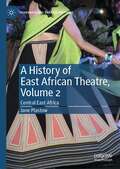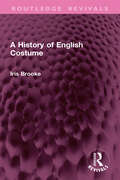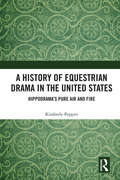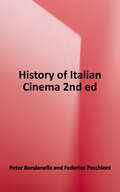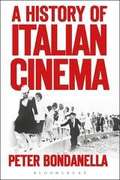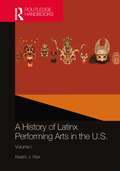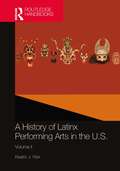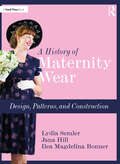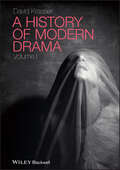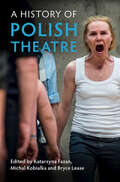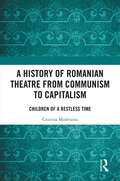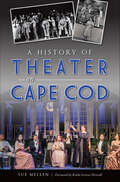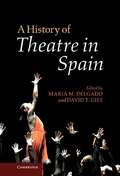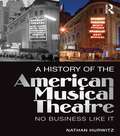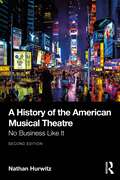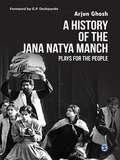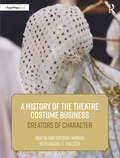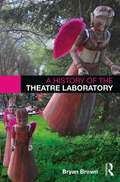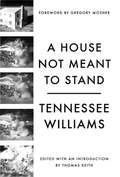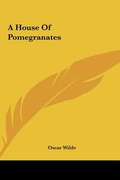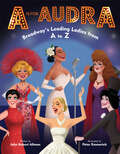- Table View
- List View
A History of East African Theatre, Volume 2: Central East Africa (Transnational Theatre Histories)
by Jane PlastowThis second volume of A History of East African Theatre focuses on central East Africa; on Burundi, Kenya, Rwanda, Tanzania and Uganda. The first chapter is concerned with francophone theatres, comparatively studying work coming out of Burundi and Rwanda alongside a focus on French language theatre in Djibouti. The chapter is particularly concerned to explore how French and Belgian cultural policies impacted theatre during the colonial period and how the French ideas of Francafrique and promotion of elite, French language art have continued to resonate in the post-colonial present. Chapters Two and Three look comparatively at the rich theatre histories of Kenya, Tanzania and Uganda, and are divided between a study of British East African colonial impact and an analysis of the post-colonial period illustrating how divergent political thought and societal make-up led to exponential differentiation in national theatres. The final chapter, on Theatre for Development and related social action theatre, covers the whole East African region, offering the first ever historicised analysis of this mode of theatre making which, since the 1980s, has come to dominate funding and opportunity in performance arts.
A History of English Costume (Routledge Revivals)
by Iris BrookeOriginally published in 1937 and reprinted as a fourth edition in paperback in 1979, this is a history of dress in England from the Norman Conquest to the mid-20th century. Despite being an excellent resource for the student or designer, this book also provides a wealth of material for the social historian. Indeed, the author argues that costume is important because it is custom, and custom and habit have helped to shape history just as much as political machinations and geographical discoveries.
A History of Equestrian Drama in the United States: Hippodrama’s Pure Air and Fire
by Kimberly PoppitiA History of Equestrian Drama in the United States documents the history of equestrian drama in the United States and clarifies the multi-faceted significance of the form and of the related stage machinery developed to produce hippodramas. The development of equestrian drama is traced from its origins and influences in the sixteenth century, through the height of the form’s popularity at the turn of the twentieth century. Analysis of the historical significance of the genre within the larger context of U.S. theatre, the elucidation of the importance of the horse to theatre, and an evaluation of the lasting impact on theatre technology are also included.
A History of Italian Cinema
by Peter Bondanella Federico PacchioniA History of Italian Cinema, 2nd edition is the much-anticipated update from the author of the bestselling Italian Cinema—which has been published in four landmark editions and will celebrate its 35th anniversary in 2018. <p><p>Building upon decades of research, Peter Bondanella and Federico Pacchioni reorganize the current History in order to keep the book fresh and responsive not only to the actual films being created in Italy in the twenty-first century but also to the rapidly changing priorities of Italian film studies and film scholars. The new edition brings the definitive history of the subject, from the birth of cinema to the present day, up to date with revised filmography as well as more focused attention on melodrama, crime film, and historical drama. <P><p>The book is expanded to include a new generation of directors as well as to highlight themes such as gender issues, immigration, and media politics. Accessible, comprehensive, and heavily illustrated throughout, this is an essential purchase for any fan of Italian film.
A History of Italian Cinema
by Peter BondanellaAn unprecedented survey of Italian film from the leading expert in the field <P><P>A History of Italian Cinema is a major new study from the author of the bestselling Italian Cinema - which has been published in three landmark editions and celebrated its twenty-fifth anniversary in 2008. Building upon his decades of research, Peter Bondanella has now written the definitive history of the subject, from the birth of cinema to the present day. He has rethought, reorganized, and completely rewritten his previous work, which focused on postwar cinema, and has broadened his coverage of the spaghetti western and comedy genres. Bondanella also now covers a huge range of work that was not previously considered, particularly both popular and 'B' genres, including: the sword and sandal epic or "peplum" film of the 1950s; the Italian horror film, the so-called spaghetti nightmare films (including the subcategories of horror, the Italian zombie and cannibal films), that began in the 1950s and continue through the present; the giallo or Italian mystery thriller; and the poliziesco or Italian crime film from the 1970s to the present. This new book also examines the emergence of a "third wave" of new auteurs born in the 1950s as well as an even younger group of important directors born in the 1960s who have already made their mark on the direction of the Italian cinema in the third millennium.
A History of Japanese Theatre
by Jonah SalzJapan boasts one of the world's oldest, most vibrant and most influential performance traditions. This accessible and complete history provides a comprehensive overview of Japanese theatre and its continuing global influence. Written by eminent international scholars, it spans the full range of dance-theatre genres over the past fifteen hundred years, including noh theatre, bunraku puppet theatre, kabuki theatre, shingeki modern theatre, rakugo storytelling, vanguard butoh dance and media experimentation. The first part addresses traditional genres, their historical trajectories and performance conventions. Part II covers the spectrum of new genres since Meiji (1868–), and Parts III to VI provide discussions of playwriting, architecture, Shakespeare, and interculturalism, situating Japanese elements within their global theatrical context. Beautifully illustrated with photographs and prints, this history features interviews with key modern directors, an overview of historical scholarship in English and Japanese, and a timeline. A further reading list covers a range of multimedia resources to encourage further explorations.
A History of Latinx Performing Arts in the U.S.: Volume I
by Beatriz J. RizkA History of Latinx Performing Arts in the U.S. provides a comprehensive overview of the development of the Latinx performing arts in what is now the U.S. since the sixteenth century. This book combines theories and philosophical thought developed in a wide spectrum of disciplines—such as anthropology, sociology, gender studies, feminism, and linguistics, among others—and productions’ reviews, historical context, and political implications. Split into two volumes, these books offer interpretations and representations of a wide range of Latinxs’ lived experiences in the U.S. Volume I provides a chronological overview of the evolution of the Latinx community within the U.S., spanning from the 1500s to today, with an emphasis on the Chicano artistic renaissance initiated by Luis Valdez and the Teatro Campesino in the 1960s. Volume II continues, looking more in depth at the experiences of Latinx individuals on theatre and performance, including Miguel Piñero, Lin-Manuel Miranda, María Irene Fornés, Nilo Cruz, and John Leguizamo, as well as the important role of transnational migration in Latinx communities and identities across the U.S. A History of Latinx Performing Arts in the U.S. offers an accessible and comprehensive understanding of the field and is ideal for students, researchers, and instructors of theatre studies with an interest in the diverse and complex history of Latinx theatre and performance.
A History of Latinx Performing Arts in the U.S.: Volume II
by Beatriz J. RizkA History of Latinx Performing Arts in the U.S. provides a comprehensive overview of the development of the Latinx performing arts in what is now the U.S. since the sixteenth century. This book combines theories and philosophical thought developed in a wide spectrum of disciplines—such as anthropology, sociology, gender studies, feminism, and linguistics, among others—and productions’ reviews, historical context, and political implications. Split into two volumes, these books offer interpretations and representations of a wide range of Latinxs’ lived experiences in the U.S. Volume I provides a chronological overview of the evolution of the Latinx community within the U.S., spanning from the 1500s to today, with an emphasis on the Chicano artistic renaissance initiated by Luis Valdez and the Teatro Campesino in the 1960s. Volume II continues, looking more in depth at the experiences of Latinx individuals on theatre and performance, including Miguel Piñero, Lin-Manuel Miranda, María Irene Fornés, Nilo Cruz, and John Leguizamo, as well as the important role of transnational migration in Latinx communities and identities across the U.S. A History of Latinx Performing Arts in the U.S. offers an accessible and comprehensive understanding of the field and is ideal for students, researchers, and instructors of theatre studies with an interest in the diverse and complex history of Latinx theatre and performance.
A History of Maternity Wear: Design, Patterns, and Construction
by Lydia Semler Jana Hill Ilea Magdelina BonnerA History of Maternity Wear: Design, Patterns, and Construction explores pregnancy clothing worn throughout the decades, providing historical information, images, and patterns. Filled with photos showing extant attire, with intricate details and sample patterns that can be recreated to scale, this book examines how maternity clothes were constructed, provides historical context, and aids readers in designing their own maternity garments. Each chapter includes examples of commonly worn maternity styles from a number of regions of the English-speaking world, with information from the United States, Britain, Australia, and Canada. The book concludes with a chapter on historically accurate underpinnings from the 17th century to the present day. A History of Maternity Wear: Design, Patterns, and Construction is written for costume professionals looking to research historically accurate characters and costumes for production, as well as fashion historians and costume enthusiasts.
A History of Maternity Wear: Design, Patterns, and Construction
by Lydia Semler Jana Hill Ilea Magdelina BonnerA History of Maternity Wear: Design, Patterns, and Construction explores pregnancy clothing worn throughout the decades, providing historical information, images, and patterns.Filled with photos showing extant attire, with intricate details and sample patterns that can be recreated to scale, this book examines how maternity clothes were constructed, provides historical context, and aids readers in designing their own maternity garments. Each chapter includes examples of commonly worn maternity styles from a number of regions of the English-speaking world, with information from the United States, Britain, Australia, and Canada. The book concludes with a chapter on historically accurate underpinnings from the 17th century to the present day.A History of Maternity Wear: Design, Patterns, and Construction is written for costume professionals looking to research historically accurate characters and costumes for production, as well as fashion historians and costume enthusiasts.
A History of Modern Drama, Volume I: 1960-2000
by David KrasnerCovering the period 1879 to 1959, and taking in everything from Ibsen to Beckett, this book is volume one of a two-part comprehensive examination of the plays, dramatists, and movements that comprise modern world drama. Contains detailed analysis of plays and playwrights, connecting themes and offering original interpretations Includes coverage of non-English works and traditions to create a global view of modern drama Considers the influence of modernism in art, music, literature, architecture, society, and politics on the formation of modern dramatic literature Takes an interpretative and analytical approach to modern dramatic texts rather than focusing on production history Includes coverage of the ways in which staging practices, design concepts, and acting styles informed the construction of the dramas
A History of Polish Theatre
by Michal Kobialka Bryce Lease Katarzyna FazanPoland is celebrated internationally for its rich and varied performance traditions and theatre histories. This groundbreaking volume is the first in English to engage with these topics across an ambitious scope, incorporating Staropolska, the Polish-Lithuanian Commonwealth, the Enlightenment and Romanticism within its broad ambit. The book also discusses theatre cultures under socialism, the emergence of canonical practitioners and training methods, the development of dramaturgical forms and stage aesthetics and the political transformations attending the ends of the First and Second World Wars. Subjects of far-reaching transnational attention such as Jerzy Grotowski and Tadeusz Kantor are contextualised alongside theatre makers and practices that have gone largely unrecognized by international readers, while the participation of ethnic minorities in the production of national culture is given fresh attention. The essays in this collection theorise broad historical trends, movements, and case studies that extend the discursive limits of Polish national and cultural identity.
A History of Romanian Theatre from Communism to Capitalism: Children of a Restless Time
by Cristina ModreanuA History of Romanian Theatre from Communism to Capitalism analyses the last three decades of Romanian theatre and connects it to the international stage. Cristina Modreanu questions the relationship between artists and power, both before 1989, behind the Iron Curtain, and in the current global political context, with nationalism manifesting itself in Eastern Europe, as seen in the critical work of Romanian theatre makers. This study covers the complex cases of theatre makers such as Lucian Pintilie, Liviu Ciulei and Andrei Șerban, who built their international careers in exile, and the most innovative Romanian artists of today, such as Silviu Purcărete, Mihai Măniuţiu, Gianina Cărbunariu, Radu Afrim, and Bogdan Georgescu, who reached the status of transglobal artists. Filling a considerable gap in Romanian theatre discourse, this book will be of a great interest to students and scholars of contemporary theatre and history.
A History of Theater on Cape Cod
by Sue MellenTheater on the Cape began in 1916 when a group of artists and writers in Provincetown mounted a production of a one-act play, Bound East for Cardiff, by a little-known playwright, Eugene O'Neill. They staged the play in a rickety old theater on a wharf in what was then little more than a sleepy fishing village. From that artists' colony--and others like it across the Cape and Islands--it grew into the constantly expanding theater universe it is today. The theatrical descendants of O'Neill and the Provincetown Players continue to present classical drama, contemporary hits and new, experimental works to audiences that have come to expect the best. In her tour of the theaters from Provincetown to Falmouth, author and entertainment columnist Sue Mellen reveals the rich past behind a unique cultural treasure.
A History of Theatre in Spain
by Maria M. Delgado David T. GiesLeading theater historians and practitioners map a theatrical history that moves from the religious tropes of Medieval Iberia to the postmodern practices of twenty-first-century Spain. Considering work across the different languages of Spain, from vernacular Latin to Catalan, Galician and Basque, this history engages with the work of actors and directors, designers and publishers, agents and impresarios, and architects and ensembles, in indicating the ways in which theater has both commented on and intervened in the major debates and issues of the day. Chapters consider paratheatrical activities and popular performance, such as the comedia de magia and flamenco, alongside the works of Spain's major dramatists, from Lope de Vega to Federico García Lorca. Featuring revealing interviews with actress Nuria Espert, director Lluís Pasqual and playwright Juan Mayorga, it positions Spanish theater within a paradigm that recognizes its links and intersections with wider European and Latin American practices.
A History of the American Musical Theatre: No Business Like It
by Nathan HurwitzFrom the diverse proto-theatres of the mid-1800s, though the revues of the ‘20s, the ‘true musicals’ of the ‘40s, the politicisation of the ‘60s and the ‘mega-musicals’ of the ‘80s, every era in American musical theatre reflected a unique set of socio-cultural factors. Nathan Hurwitz uses these factors to explain the output of each decade in turn, showing how the most popular productions spoke directly to the audiences of the time. He explores the function of musical theatre as commerce, tying each big success to the social and economic realities in which it flourished. This study spans from the earliest spectacles and minstrel shows to contemporary musicals such as Avenue Q and Spiderman. It traces the trends of this most commercial of art forms from the perspective of its audiences, explaining how staying in touch with writers and producers strove to stay in touch with these changing moods. Each chapter deals with a specific decade, introducing the main players, the key productions and the major developmentsin musical theatre during that period.
A History of the American Musical Theatre: No Business Like It
by Nathan HurwitzFrom the diverse proto-musicals of the mid-1800s, through the revues of the 1920s, the ‘true musicals’ of the 1940s, the politicization of the 1960s, the ‘mega-musicals’ of the 1980s, and the explosive jukebox musicals of the 2010s and ’20s, every era in American musical theatre reflected a unique set of socio-cultural factors. This new edition has been brought up to date to include musicals from the last ten years, reflecting on the impact of Covid-19 and the state of the contemporary musical theatre industry.Author Nathan Hurwitz uses these factors to explain the output of each decade in turn, showing how the most popular productions spoke directly to the audiences of the time. He explores the function of musical theatre as commerce, tying each big success to the social and economic realities in which it flourished. This textbook guides students from the earliest spectacles and minstrel shows to contemporary musicals such as Hadestown, Six, and Back to the Future. It traces the trends of this most commercial of art forms from the perspective of its audiences, explaining how staying in touch with writers and producers strove to stay in touch with these changing moods. Each chapter deals with a specific decade, introducing the main players, the key productions, and the major developments in musical theatre during that period. This new edition has been updated to include the 2010s and 2020s, including the impact of Covid-19 on the American Musical Theatre industry, and new features such as end-of-chapter questions for class discussions.Ideal for undergraduate students of Musical Theatre, this is the most comprehensive and accessible guide to the history of the American Musical from the mid-1800s to the present day.
A History of the Jana Natya Manch
by Arjun GhoshA History of the Jana Natya Manch chronicles the birth and growth of the Jana Natya Manch (Janam), a Delhi-based radical theater group which has been active since 1973. Beginning in the early 1970s, when a group of young students in Delhi sought to continue the legacy of the Indian Peoples' Theatre Association, the book takes a close but critical look at the various phases in the four decades of the theatre collective. The author has also captured within these pages the functioning of Janam as an organization, its methods of attracting and training fresh talent, the process of scripting, interactions with mass organizations, the experience of performing almost skin-to-skin with its spectators in the grime of Indian streets, and much more. This book is not only a narration of Janam's history, development and functioning, it is also an attempt to throw fresh light on the practice of theater.
A History of the Theatre Costume Business: Creators of Character
by Triffin I. Morris Gregory DL MorrisA History of the Theatre Costume Business is the first-ever comprehensive book on the subject, as related by award-winning actors and designers, and first hand by the drapers, tailors, and craftspeople who make the clothes that dazzle on stage. Readers will learn why stage clothes are made today, by whom, and how. They will also learn how today’s shops and ateliers arose from the shops and makers who founded the business. This never-before-told story shows that there is as much drama behind the scenes as there is in the performance: famous actors relate their intimate experiences in the fitting room, the glories of gorgeous costumes, and the mortification when things go wrong, while the costume makers explain how famous shows were created with toil, tears, and sweat, and sometimes even a little blood. This is history told by the people who were present at the creation – some of whom are no longer around to tell their own story. Based on original research and first-hand reporting, A History of the Theatre Costume Business is written for theatre professionals: actors, directors, producers, costume makers, and designers. It is also an excellent resource for all theatregoers who have marveled at the gorgeous dresses and fanciful costumes that create the magic on stage, as well as for the next generation of drapers and designers.
A History of the Theatre Costume Business: Creators of Character
by Triffin I. Morris Gregory DL Morris Rachel E. PollockA History of the Theatre Costume Business is the first-ever comprehensive book on the subject, as related by award-winning actors and designers, and first hand by the drapers, tailors, and craftspeople who make the clothes that dazzle on stage.Readers will learn why stage clothes are made today, by whom, and how. They will also learn how today’s shops and ateliers arose from the shops and makers who founded the business. This never-before-told story shows that there is as much drama behind the scenes as there is in the performance: famous actors relate their intimate experiences in the fitting room, the glories of gorgeous costumes, and the mortification when things go wrong, while the costume makers explain how famous shows were created with toil, tears, and sweat, and sometimes even a little blood. This is history told by the people who were present at the creation – some of whom are no longer around to tell their own story. Based on original research and first-hand reporting, A History of the Theatre Costume Business is written for theatre professionals: actors, directors, producers, costume makers, and designers. It is also an excellent resource for all theatregoers who have marveled at the gorgeous dresses and fanciful costumes that create the magic on stage, as well as for the next generation of drapers and designers.
A History of the Theatre Laboratory
by Bryan BrownThe term ‘theatre laboratory’ has entered the regular lexicon of theatre artists, producers, scholars and critics alike, yet use of the term is far from unified, often operating as an catch-all for a web of intertwining practices, territories, pedagogies and ideologies. Russian theatre, however, has seen a clear emergence of laboratory practice that can be divided into two distinct organisational structures: the studio and the masterskaya (artisanal guild). By assessing these structures, Bryan Brown offers two archetypes of group organisation that can be applied across the arts and sciences, and reveals a complex history of the laboratory’s characteristics and functions that support the term’s use in theatre. This book’s discursive, historical approach has been informed substantially by contemporary practice, through interviews with and examinations of practitioners including Slava Polunin, Anatoli Vassiliev, Sergei Zhenovach and Dmitry Krymov.
A House Not Meant to Stand
by Tennessee WilliamsChristmas 1982: Cornelius and Bella McCorkle of Pascagoula, Mississippi, return home one midnight in a thunderstorm from the Memphis funeral of their older son to a house and a life literally falling apart--daughter Joanie is in an insane asylum and their younger son Charlie is upstairs having sex with his pregnant, holy-roller girlfriend as the McCorkles enter. Cornelius, who has political ambitions and a litany of health problems, is trying to find a large amount of moonshine money his gentle wife Bella has hidden somewhere in their collapsing house, but his noisy efforts are disrupted by a stream of remarkable characters, both living and dead. While Williams often used drama to convey hope and desperation in human hearts, it was through this dark, expressionistic comedy, which he called a "Southern gothic spook sonata," that he was best able to chronicle his vision of the fragile state of our world.
A House of Pomegranates
by Oscar WildeA House of Pomegranates is a collection of fairy tales, written by Oscar Wilde, that was published in 1891 as a second collection for The Happy Prince and Other Tales (1888). Wilde once said that this collection was "intended neither for the British child nor the British public." <P> <P> The stories included in this collection are as follows: The Young King The Birthday of the Infanta The Fisherman and his Soul The Star-Child
A Is for Audra: Broadway's Leading Ladies from A to Z
by John Robert Allman"It's an incredible honor to be included in this amazing book of the greatest talent the Broadway stage has ever known!"—AUDRA McDONALD, six-time Tony Award-winning actressFrom Audra McDonald to Liza with a "Z," here is a showstopping alphabet book featuring your favorite leading ladies of the Broadway stage!Step into the spotlight and celebrate a cavalcade of Broadway's legendary ladies. Start with "A" for six-time Tony Award winner Audra McDonald, then sing and dance your way through the alphabet with beloved entertainers like Patti LuPone, Bernadette Peters, Chita Rivera, Lea Salonga, Kristin Chenoweth, Kelli O'Hara, and Liza Minnelli! Broadway fans and theater lovers everywhere will give a standing ovation to this one-of-a-kind tribute full of toe-tapping rhymes, with illustrations as bright and beautiful as the shining lights on any marquee.AND DON'T MISS THE SEQUEL COMING IN OCTOBER: B IS FOR BROADWAY: ONSTAGE AND BACKSTAGE FROM A TO Z!THE RAVE REVIEWS ARE IN FROM THE STARS THEMSELVES! A wonderful, enriching, enlightening book for theater lovers of all ages . . . and all that jazz!"—CHITA RIVERA, two-time Tony Award-winning actress (The Rink, Kiss of the Spider Woman)"A to Z—awesome to zany—I'm thrilled to be a part of such an illustrious group."—CHRISTINE EBERSOLE, two-time Tony Award-winning actress (42nd Street, Grey Gardens)"I'm so honored to be included among these fierce ladies—brought to life with such fun illustrations—in this wonderful book for little divas like my own!"—LEA SALONGA, Tony Award-winning actress (Miss Saigon)"A is for Audra turns the alphabet song into a show stopper! It is literally a love letter to Broadway's leading ladies, and I am so honored to be memorialized alongside all of my sisters!"—RENÉE ELISE GOLDSBERRY, Tony Award-winning actress (Hamilton)"I'm honored to be included in this illustrious group. A to Z, they are all incredible!"—KRISTIN CHENOWETH, Tony Award-winning actress (You're a Good Man, Charlie Brown)"What a fun and fabulous celebration of the females of Broadway! Imagine my joy just to be a part of it!"—KELLI O&’HARA, Tony Award-winning actress (The King and I)&“H is also for honored—because that&’s what I am to be included in this beautiful book. I can&’t wait to show my kids and tell them of all the brilliant leading ladies who have graced the Broadway stage.&” —HEATHER HEADLEY, Tony Award–winning actress (Aida)AND CRITICS LOVE IT TOO! "Women of the Broadway theater take center stage in this loving homage. . . . A lively introduction to a whole new cast of heroines."—Kirkus"this is a book all kids (and many adults) will enjoy as they learn about and fall in love with the theatre."—Playbill.com"A true necessity for any kid&’s bookshelf."—Entertainment Weekly&“a thorough, eye-catching introduction to women of the theater. . . . budding theater lovers will get a thrill.&”—Booklist"A sure hit for thespians of all ages."—School Library Journal"Emmerich&’s flattering caricatures, paired with [Allman&’s] verse, are colorful and slick, bringing Broadway&’s drama to the page&”—Publishers Weekly
A Jacobean Company and Its Playhouse
by Eva GriffithEva Griffith's book fills a major gap concerning the world of Shakespearean drama. It tells the previously untold story of the Servants of Queen Anna of Denmark, a group of players parallel to Shakespeare's King's Men, and their London playhouse, The Red Bull. Built in vibrant Clerkenwell, The Red Bull lay within the northern suburbs of Jacobean London, with prostitution to the west and the Revels Office to the east. Griffith sets the playhouse in the historical context of the Seckford and Bedingfeld families and their connections to the site. Utilising a wealth of primary evidence including maps, plans and archival texts, she analyses the court patronage of figures such as Sir Robert Sidney, Queen Anna's chamberlain, alongside the company's members, function and repertoire. Plays performed included those by Webster, Dekker and Heywood -- entertainments characterized by spectacle, battle sequence and court-room drama, alongside London humor and song.
